If you've ever wanted to grow a bonsai tree, but aren't sure if you have the discipline, you should try an elephant bush. Also known as dwarf jade, porkbush, and spekboom, the elephant bush is a popular semi-perennial succulent shrub.
Elephant bush has a reddish-brown stem and small glossy green leaves. There are several variants, the most common of which is the variegated type. The leaves of the variegated type, also known as 'rainbow elephant bush,' are green with cream and sometimes pink edging.
Elephant bush is an attractive and dynamic succulent, with many sides to its personality. It is an ornamental plant that also happens to be a popular snack for humans and other animals. Its tendency is to grow upward, downward, and outward. It takes well to pruning, but it also looks great when allowed to sprawl. It contributes lots of visual interest when potted in an arrangement with other succulents, but it can stand on its own as well. It is even recognized as an atmospheric carbon sponge with potential use in reforestation.
Portulacaria Afra makes a great first bonsai tree because it is drought tolerant, so it is resilient to inattention and relatively low-maintenance (compared to other bonsais). It grows slowly enough to be trained into very attractive shapes. It is also simple to propagate. All in all, it is a great addition to any sunny windowsill.
Quick Guide to Elephant Bush
Sun requirements
Elephant bushes prefer a lot of sunlight. Inadequate sunlight can cause the plant to drop its leaves to conserve energy. It can also cause the branches to have larger gaps of stem between leaves, giving it a stretched-out appearance.
However, this plant is also susceptible to sunburn. Outdoors, avoid planting it in areas with direct, unfiltered sunlight all afternoon. The ideal is at least 5-6 hours of morning or bright but dappled afternoon sunlight. Indoors, direct sunlight in a south facing window is best.
Hardiness
Elephant bush prefers temperatures of 70-85 degrees Fahrenheit during the day and 50-55 degrees at night. It is typically not cold-hardy (except for brief periods of time, and only when the plant is very mature).
It should only be planted in the ground where winters are reliably warm, generally in USDA zone 9 or higher. However, you can also grow it in a pot and bring it inside your home during cooler months.
Elephant bush does best when temperatures transition gradually. If you grow it in a pot outside during the spring-fall, make sure to bring it indoors before the outside temperature drops much below your indoor temperatures, or bring it in gradually. Otherwise, if it is adapted to cooling outdoor temperatures and then brought inside where it is much warmer (or vice versa, when you take it outside in the spring), you may experience leaf drop.
Toxicity
Like Zebra plants, Elephant bush is non-toxic for humans and pets. In fact, they are commonly eaten in South Africa in soups or salads as well as being used medicinally. They have a tart flavor, are high in vitamin C, and have an appealing juicy crunch.
Elephant bush is also consumed by animals ranging from elephants to tortoises. It is a perfect plant for homes with untrustworthy pets. However, it is a slow grower, so it's best to keep your plant out of pets' reach to stop frequent munching.
Primary growth season
Elephant bush is typically dormant in the winter. It grows slowly, but most of its growth is in the spring and summer.
Typical sizes
Although elephant bush is often purchased as a tiny plant, and you can keep it small through pruning, it has the capacity to grow quite large. In its native environment, elephant bush has been known to grow twenty feet tall. In the garden it tends to top out at six to eight feet. A mature indoor plant might only be three to four feet.
When the plant's limbs get long they tend to become heavy and fall off, so support may be needed.
Flowers
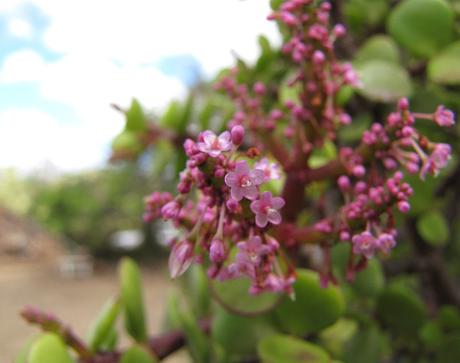
Elephant bush is grown mainly for its attractive foliage and structure. It rarely flowers in cultivation. However, healthy, mature plants can produce flowers in the summer. The small clusters of tiny pink or white flowers can last several weeks. However, don't be surprised if you don't get any flowers on an indoor elephant bush.
Growing the Elephant bush
Where to Plant
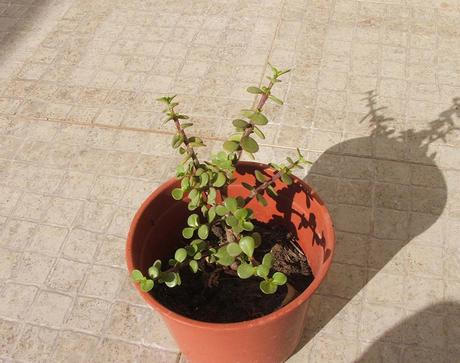
Elephant bush can be grown outdoors in Zones 9-12. It is generally drought tolerant and resilient, even above 100 degrees in the summer. However, it is susceptible to sunburn.
Whether indoors or outdoors, it is important to locate your elephant bush where it can get adequate sunshine. Aim for at least 5-6 hours of moderate sunlight per day.
If you are keeping it as a houseplant, the best place for an elephant bush is in a south-facing window. If you don't have a place for it with sufficient bright direct sunlight, give it a little time under a grow light periodically.
Outdoors bright filtered sunlight is best. It wants a lot of light, but you should avoid placing it in direct mid-afternoon sun. Doing so can result in reddish-brown discoloration of the leaves.
If you are planning to move an indoor elephant bush outdoors, make sure to do it gradually. You can either start with limited but increasing hours of time outdoors each day, or start it in a location with dappled sunlight and gradually move the pot to an area with more direct sun exposure.
Container
Like all succulents, elephant bush needs excellent drainage. Use a pot with a large drainage hole in the bottom. An unglazed pot is ideal, as it will absorb excess moisture from overwatering.
As with any water-sensitive succulent, avoid using a pot that is too large for the plant. A large container filled with too much soil will retain moisture for too long, encouraging root rot. An elephant bush has very adaptable roots, so it can grow happily in a shallow container meant for a bonsai plant.
Soil
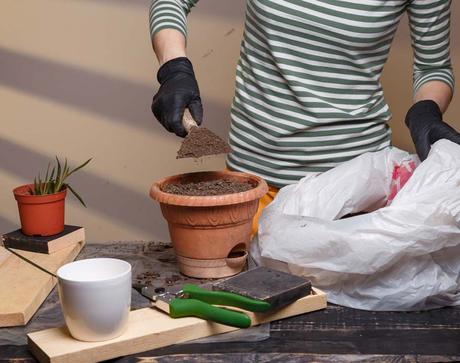
Elephant bush needs well-draining soil. You can use a well-draining succulent or cactus mix, or make your own potting medium.
This is a simple recipe for elephant bush potting medium:
- Two parts potting soil,
- One part sharp sand (optional), and
- One part gritty amendment, such as perlite, pumice, pebbles, bark chips, pieces of broken pots, etc.
Maintenance and Repotting
Repot if your elephant bush turns yellow from lack of soil nutrients, if the soil does not retain adequate moisture, or when the plant becomes overgrown. Roots growing out of the drainage holes is a good indicator. Typically every few years is sufficient.
Watering
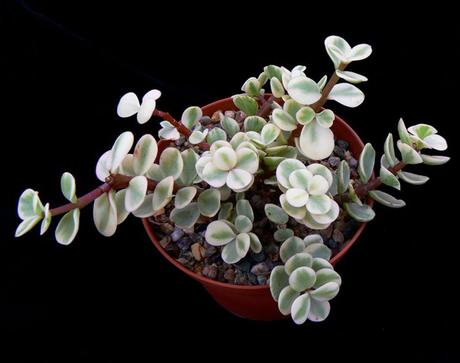
An excess of water is the bane of the elephant bush. The variegated variety needs a bit more water than the standard variety, however.
It is important to find a good balance. Elephant plants are drought tolerant, but they grow more quickly and healthily if properly watered. On the other hand, overwatering can cause leaf drop, root rot, and puts the plant at greater risk of opportunistic pests. Severe overwatering can also cause dark brown or black spots to develop on the trunk of the plant as it rots from the ground up.
You can avoid overwatering your elephant bush by limiting watering to once every week or two during the growing season (spring through fall), and by using the "soak and dry" method:
- Confirm that the soil is fully dry to at least an inch of depth.
- Place the pot in a sink and gently water the plant until water streams out of the drainage hole in the pot's bottom.
- Wait a few minutes for the water to absorb throughout the soil as much as possible.
- Drench the soil again, to make sure the potting mix is completely saturated.
- Let the pot drain well so that it does not accumulate water in its saucer.
- Move the plant back to its home.
- Let the potting mix dry fully before watering again.
A good indicator the plant is thirsty is when the leaves begin to curl up slightly. If the leaves become shriveled, dull and limp, and feel flattened or deflated, water more frequently. Dropped leaves can also be a sign of underwatering, but they will not be soggy like leaves dropped due to overwatering.
If the leaves seem to become shriveled faster than they should, pay attention to how quickly your plant drains when watered. If the soil seems to be absorbing very little water, you may want to consider repotting your elephant bush into a higher percentage of soil and a lower percentage of sand and perlite (or other drainage promoting medium) than you are currently using.
If the leaves become yellow and transparent or the trunk or leaves become mushy, let it dry out and then water less frequently.
Elephant plants do not need extra humidity, such as misting. However, dust can clog up the plant's pores, so rinse the leaves in the sink occasionally when you water it.
Corking
Some people overwater their succulents as a result of misunderstanding the phenomenon called "corking." Corking occurs when the mature stems of your elephant bush develop a hard, wood-like texture.
Corking is a natural part of the growth cycle. When the mature arms become heavy, the stem corks in order to provide more stability and avoid breakage.
Corking is non-reversible; it cannot be corrected with extra water. If you don't like the look of corking you will need to propagate your plant and start over.
Fertilizing
Elephant bush has low feeding needs, so you won't typically need to fertilize it for the first year after you purchase it new or repot it in fresh potting mix. After that, use a liquid cactus fertilizer, preferably organic, diluted to half strength. Apply this mixture every other month or so, except when it is dormant.
If you have yellowing leaves, and you are watering correctly, the discoloration may be a sign that your potting mix is not providing adequate nutrients to your elephant bush. If it has been a few years, consider repotting with fresh potting mix.
Pests and Disease
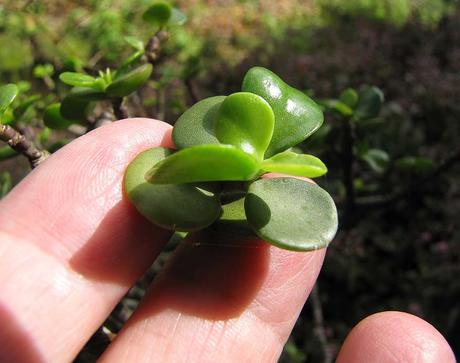
Most problems with the elephant bush are related to overwatering, or sun related problems (sunburn, inadequate sun, transitioning from indoors to outdoor sun too quickly, etc.). No special care is needed in most cases, other than to adjust the location or watering frequency.
If your elephant bush develops black rot spreading up the stem, from overwatering, the base of the plant will probably be unsalvageable. You can try moving it to a hot sunny spot to dry it out, but most likely if you want to save it you will need to propagate it by cutting off the healthy stem above the highest spot the black rot has reached and planting those pieces.
If you are dealing with sunburn, move your elephant bush to a location with less strong direct sunlight. Water as normal; do not try to compensate for sunburn with extra water.
One of the few pests that attack indoor elephant bushes are mealybugs. Mealybugs look like crumbs and tend to live in a white web-like substance inside the nooks and crannies of your succulents. They can be killed with a little isopropyl alcohol on a q-tip or in a spray bottle. Cleaning the plant with lightly soapy water can also help (and will get rid of the sticky residue left on leaves by the mealybugs).
Propagation
Elephant bush is easy to propagate, either from leaves or stem cuttings. In fact, it will often propagate itself if dropped leaves or branches are left on the soil. However, leaf propagation takes a long time, so most people prefer to use stem cuttings.
Propagation is most likely to be successful if you take your cuttings in the spring or summer. However, if a branch drops off because it has become too heavy without support, there's no reason not to propagate it, regardless of the time of year.
To propagate elephant bush with stem cuttings:
- Use a sharp, sterile knife or scissors to cut a three-inch (or longer) section of healthy branch from the mother plant. Make sure to choose a piece of stem that has some leaves on it.
- Leave the cuttings lying on a plate or table in the open air (out of direct sunlight) for several days after cutting it. Keep it dry and out of direct sunlight. This will allow the raw area to heal over, forming a callus. This step, curing the cutting in open air, is important to avoid bacterial or fungal growth at the cut end.
- After the callus has formed, you have the option of dipping the cut end in a rooting hormone. This is typically unnecessary, but it can speed up the rooting process.
- Plant the callus end in moist, well-draining soil. Place the pot in moderate sunlight, where the temperature is at least 65 degrees Fahrenheit.
- Don't overwater, but avoid letting the soil dry out.
- It should only take 3-6 weeks for your cuttings to grow a good root system. At that point you can repot the baby elephant bushes and move them to an area with more sun exposure.
Here's a video tutorial:
Water propagation is also an option.
If you do want to try leaf propagation, and are patient, you can just leave some of the leaves that drop off the plant lying on the soil. Some will sprout leaves, and they can be replanted. However, they will take a long time to grow sizable branches.
Conclusion
Whether you prune it into an elegant bonsai tree or let it sprawl over the edge of a hanging planter, the elephant bush is a beautiful, multidimensional plant. Enjoy it for the foliage, the challenge of trying to get it to flower, or even for the occasional snack.
